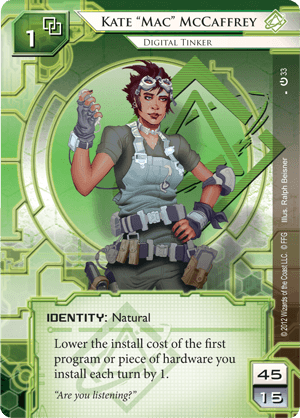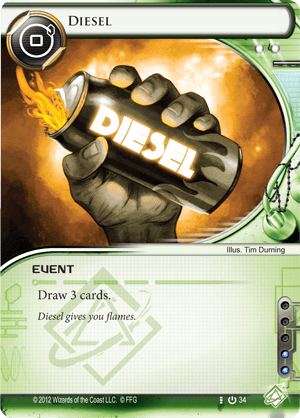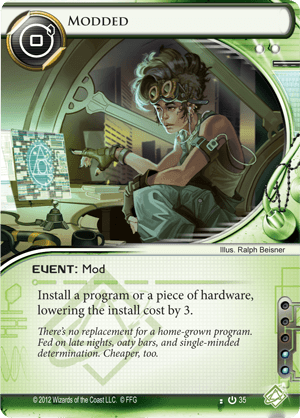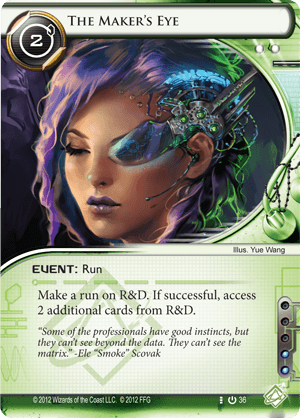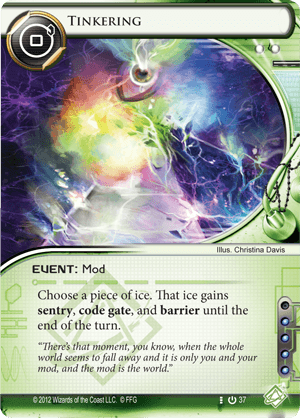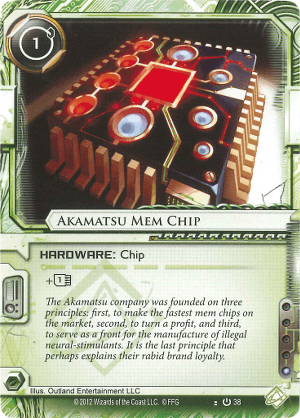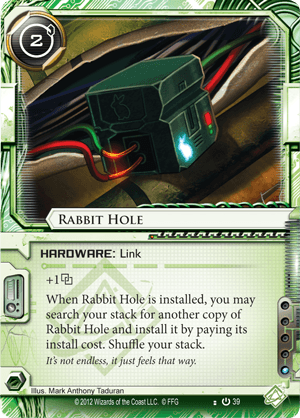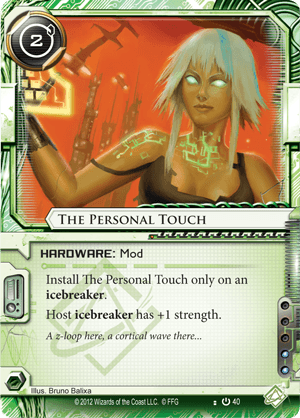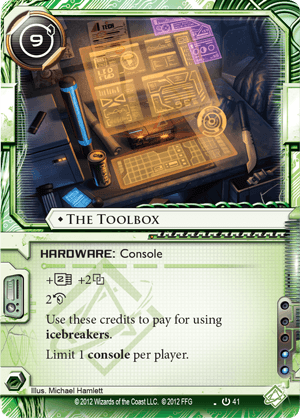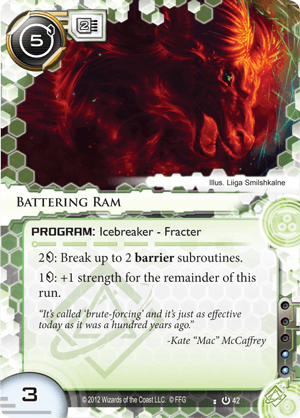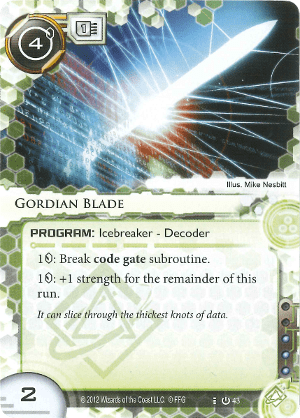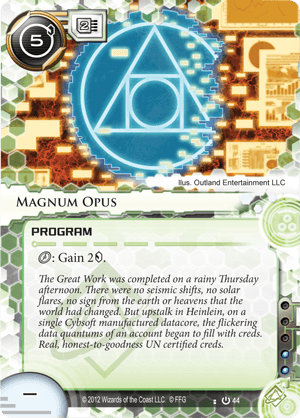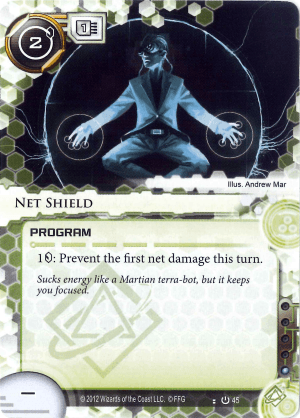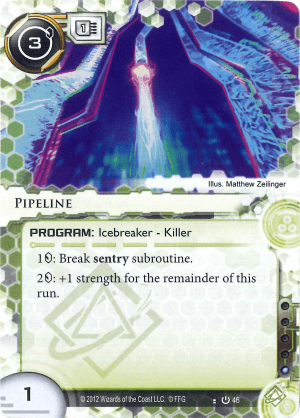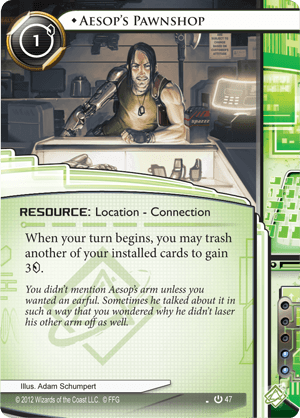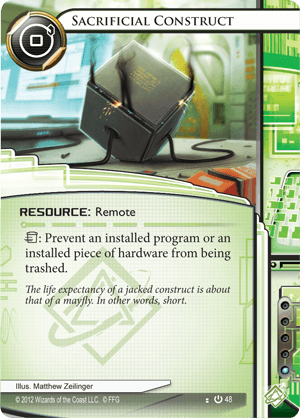It's been about a week and a half since the last store championship I attended. I'd like to think I've been spending the time since then reflecting on my performance, but instead I've been distracting myself with other pursuits. That said, let's go over what I came up with and how it performed.
Economic Strategy - 45 cards
Identity: Laramy Fisk - Savvy Investor
Programs
Alias - 3
Breach - 3
Passport - 3
Sneakdoor Beta - 2
Hardware
Dyson Mem Chip - 3
Resources
Kati Jones - 3
Same Old Thing - 3
Temüjin Contract - 2
Events
Account Siphon - 2
Easy Mark - 3
Fisk Investment Seminar - 3
Legwork - 3
Notoriety - 3 (3 influence)
Quest Completed - 3 (6 influence)
Sure Gamble - 3
The Maker's Eye - 3 (6 influence)
I really would like Laramy Fisk to be a good identity. I suppose the issue is that almost every other Criminal identity has what seems to be a more useful ability. Anyway, the main idea is to attack core servers to set up for using Notoriety to score extra points or Quest Completed to access agendas. Quest Completed is particularly interesting, because it can get around cards that would otherwise hinder a run on a remote server, such as Ash 2X3ZB9CY or Caprice Nisei. Granted, a better solution might be Unregistered S&W '35 or Drive By. Another big issue is that the deck has very little recursion, so once you've gone through everything once, you're done. Plus, there's no Inside Job, which means you can't really pressure servers with just one piece of ice. Also, it would probably be a good idea to throw in some copies of Emergency Shutdown as well.
Still, the idea could work. Right now, I'm thinking of rebuilding this deck using Ken "Express" Tenma as the identity.
Low-Cost Operation - 54 cards
Identity: Near-Earth Hub - Broadcast Center
Agendas (24 points)
15 Minutes - 1
AstroScript Pilot Program - 1
Breaking News - 2 (-2 max influence)
Chronos Project - 1
Global Food Initiative - 3 (3 influence)
License Acquisition - 3
Project Beale - 3
Ice
Data Raven - 3
Data Ward - 3
Pop-up Window - 3
Tollbooth - 3
Vanilla - 3
Assets
Blacklist - 3
Daily Business Show - 3
Jackson Howard - 3
Mumba Temple - 3 (-3 max influence)
Museum of History - 3
PAD Campaign - 3
The Root - 3 (9 influence)
Upgrades
Breaker Bay Grid - 3
Operations
Shipment from SanSan - 3
Sweeps Week - 3
To be honest, I thought there would be a lot more instances of Account Siphon and Beth Kilrain-Chang in this tournament, so I wanted to come up with a deck idea that could operate while maintaining a low credit pool. Granted, I didn't seem to encounter these cards that often. On the surface, it's pretty much a standard asset spam deck. I guess the really big issue is that the deck isn't geared for fast advance, meaning that you have to assemble a decent remote server in order to score anything out, unless you are good at bluffing the runner.
Now onto the matches.
Round 1: vs. Natalie
NEH vs. Adam: 9 - 6 W
Fisk vs. Blue Sun: 2 - 8 L
Kind of off to a promising start. I opened the corp game holding a Vanilla and a Pop-Up Window, which I used to protect the centrals. I was able to get The Root up early as well. I ended up losing a few agendas early on due to not protecting them against Always Be Running. Still, I was able to slow roll out the rest of the agendas eventually. Second game was not so great. I couldn't get my rig up as fast as I would have liked, and it would seem the deck idea doesn't perform as well against glacier style decks.
Round 2: vs. Eden
NEH vs. Ele "Smoke" Scovak: 5 - 7 L
Fisk vs. Chronos Protocol: 7 - 5 W
And now things start going downhill for my corporation concept. I was able to get The Root up early again, and put a Tollbooth on R&D and a Vanilla on HQ. Still, I took too much time and he was able to get his rig setup, which let him win. Second game, it took me some time to get setup as Fisk. Although, I was able to steal a copy of The Future Perfect with Quest Completed, so that worked out well. Later on, at 6 points, I made my last few runs intending to win with Notoriety, but he had dumped agendas into Archives, which meant I had won before I could do so.
Round 3: vs. Jefferson
NEH vs. Valencia: 3 - 8 L
Fisk vs. Potential Unleashed: 9 - 4 W
Another not so great corp game. I was able to sneak through a Beale, scoring it on turn 2. He got out a Nerve Agent, and was using it to try and lock down HQ, but fortunately I had no agendas there. I wiped the virus counters, but he was then able to get out a Medium and used DDoS and Blackmail to build up a bunch of counters on it, snagging 6 points off of the deck in the process. So that left me with a difficult choice: either score out the agenda I had in a server, or clear virus tokens. I decided to score out, since there was a chance the deck wouldn't give anything. Clearly, that didn't happen. Second game, I was able to get a Temüjin contract in my opening hand, so I used that to gain 12 credits on the first turn. After that, I was able to build up my rig and snag agendas out of R&D and HQ. I then took his Philotic Entanglement through Quest Completed. At the end, I managed to drain him, then made a glory run onto a remote server. It turned out the piece of ice protecting it was not the one he thought it was, and I was able to snag the last agenda for the game.
Round 4: vs. Aaron W.
NEH vs. Kate: 6 - 8 L
Fisk vs. NEXT Design: 4 - 7 L
Game one, I was able to sneak through Astrocript, which I then used to score a Beale. I was also able to sneak through a License Acquisition, but he was able to hammer my deck afterwards, taking 5 points. I put another Beale behind a Data Raven & 2 Data Wards, but he used Stimhack to get enough money to break through and steal it. Game two, he was able to get 3 pieces of ice for his ability, defending HQ, R&D and a remote. He then used Biotic Labor to score an Accelerated Beta Test, which gave him 2 copies of NEXT Bronze. I was able to snag a GFI and a Project Vitruvius, but he scored another ABT and then another GFI. Once again, not much I could do against a glacier deck.
And so that was it. Out of 18 or 19 players (one person had to drop out partway through,) I placed 14th. The odd thing was the corp deck I thought would do well performed poorly, while the runner deck which I thought wouldn't do well did okay. I guess I still need to work on my ideas.
Until next time, watch out for social engineering.
Wednesday, January 18, 2017
Sunday, January 1, 2017
Card Analysis - Core Shaper
Happy New Year! To kick this new year off, I'm going back to analyzing all of the cards so far. Last time, I looked at the cards for Criminals out of the core set, so now I'm moving on to the Shaper cards.
Kate "Mac" McCaffrey: Digital Tinker
Out of just the core box, Kate is one of the strongest runners. Her ability helps with any economy, and can be used practically every turn. In fact, it can even be used on the corporation's turn if you have a way to install a program or hardware during their turn. Plus, starting with 1 link strength makes it harder for traces to stick on you. It's no wonder that this is one of the most tournament winning identities for Shaper.
Pair cards: all programs and hardware
Diesel
Getting 3 cards for 1 click is a great proposition. Especially for the runner, who can lose the game by taking too much damage at once. Whether you need to dig through the deck for that one specific card or are just rebuilding your hand, this event is a great way to do it. Plus, the 2 influence means it can be easily splashed into other factions.
Trivia: Another reprint of sorts from the Netrunner CCG. The original card was called Jack 'n' Joe, and gave us the great flavor text, "There's too much blood in my caffeine system."
Pair cards: Faust, any time you need more cards.
Modded
There are a lot of quite expensive programs and hardware out there, and they tend to be exceptional. But building up all the credits you need to install them and then rebuilding your credits afterwards can be a pain. With this card, you can mitigate the cost, allowing you to install your costly programs and hardware sooner, and start getting more use out of them. And yes, this card does stack with Kate's ability, meaning if it's the first program or hardware you are installing that turn, the cost is lowered by 4.
Trivia: Not exactly a reprint, but there's a similar card from the CCG's expansion Proteus called Hijack. It costs 1 to play and gives you 3 credits to spend for installing a program or hardware.
Pair cards: Expensive programs and hardware
The Maker's Eye
We now start to get more into defining what the Shaper archetype is. Anarchs seem to primarily deal with the Archives, Criminals attack the HQ, but Shapers dig through the R&D. This card makes you access additional cards out of R&D for one run, which could be good, as you get to see more cards. Although, that can be a double edged sword against corporation decks with traps that fire on access.
Trivia: Another reprint from the CCG, where it was called Custodial Position.
Pair cards: Same Old Thing, Planned Assault, Public Terminal
Tinkering
Not something you see that much nowadays, but a solid card. You pick a piece of ice, and it doesn't have to be rezzed, and it gains a copy of each of the primary ice subtypes. This means that you can now break a piece of ice even if you don't have the specific breaker for it. It's only good for one turn, but that can be all you need to grab an agenda.
Pair cards: icebreakers
Akamatsu Mem Chip
It's cheap, it boost your available memory, it only costs 1 influence. If you're going to be using programs that take up a lot of memory, you may want to put this into your deck. The only downside is the core only comes with 2 copies of this card, so you may want to pick up a second core set to make effective use of this.
Trivia: Yep, it's another reprint. This time, the original card was called WuTech Mem Chip.
Pair cards: Overmind, Data Folding, large programs
Rabbit Hole
Not exactly the cheapest solution to boosting your link strength, but one of the most interesting ones. Each adds 1 link strength, but if you have 6 credits, you can pull the others out of your deck and install them all simultaneously. This thins out your deck, meaning you can draw the cards you want sooner. But, once again, there are only 2 copies of this in the core, so to make effective use out of it, you'll need a second core set.
Trivia: Possibly a reference to The Matrix, wherein Morpheus tells Neo that if he takes the red pill, he will show him how deep the Rabbit Hole goes.
Pair cards: Security Nexus, Underworld Contact, Citadel Sanctuary, anything that traces
The Personal Touch
Considering that most icebreakers allow you to spend credits to increase their strength, paying 2 credits to permanently increase strength by 1 seems like a pointless prospect. But consider this: for 2 credits once, you will be paying out credits less to boost strength, which can quickly add up on multiple runs. Plus, for the icebreakers that can't increase their strength, this lets you get around needing to lower the strength of the ice, so you don't have to spend your Datasucker tokens as much.
Trivia: Sort of a reprint here again. There's a card from the Proteus expansion called The Personal Touch which boosts the strength of an icebreaker, except it's a Prep (event,) it costs 4 to play, and it places a token on the icebreaker instead of being hosted on it.
Pair cards: Yog.0, Mimic, Morning Star
The Toolbox
Expensive, but decidedly worth it. 2 extra memory, 2 extra link strength, and 2 recurring credits for using icebreakers. This means you need fewer credits to break ice during runs or to beat traces, allowing you to spend those credits on trashing assets or upgrades, or on other costs.
Pair cards: Modded, Inside Man
Battering Ram
Moderately more expensive, and not necessarily as efficient as Corroder, but it does have an interesting ability. Boosting its strength means it stays boosted for the rest of the run. So if the corporation piles up multiple barrier ice on a server, you don't have to spend lots of credits boosting the strength of Battering Ram over and over. The downside is that the break ability cost 2 credits to break up to 2 subroutines, so you'll be spending 2 credits to break 1, 4 credits to break 3, and so on.
Pair cards: Cyberfeeder, Dyson Fractal Generator, Multithreader
Gordian Blade
The quintessential decoder of the core. Cheap enough to install, super efficient, and has the boosted strength for the remainder of the run effect, so if the corp has a large code gate at the front of a server and smaller ones closer in, you don't have to keep paying to boost this one. The 3 influence cost makes it a bit harder to splash into other factions, but it's still good enough to consider doing so.
Trivia: A reference to the Gordian Knot, a fable of a puzzle where a knot was so complicated that whoever could undo it would be made king, only for Alexander the Great to solve it by slicing through it with his sword.
Pair cards: Cyberfeeder, The Toolbox, Lockpick
Magnum Opus
Somewhat expensive, but it is one of the most reliable economy cards. With this installed, instead of taking 1 credit per click, you get 2, which means you need less time rebuilding your credit pool. Getting this card in your starting hand can settle your economy for the rest of the game. Still, it is a memory hog, so make sure to install some memory chips or a console so you have space for this and the rest of your programs.
Trivia: Another reprint, down to the cost, memory cost, and effect. It was originally called Newsgroup Filter.
Pair cards: Akamatsu Mem Chip, Dyson Mem Chip, Self-modifying Code, Test Run
Net Shield
Not something that is commonly run. Preventing 1 net damage for 1 credit would be very powerful, but this only prevents the first point of net damage, so any more will still be taken. Also, net damage only tends to come up in Jinteki decks, although it is possibly to see Assassin in any deck, so this could mitigate damage from that card.
Pair cards: Omni-drive, Djinn
Pipeline
Again, not commonly used, mostly because people prefer other killers. Interestingly, it does have the boosted strength for the remainder of the run effect, but since it costs 2 credits for that, it becomes expensive quite rapidly. Still, it has a low install cost and a very low influence cost, but I think in most cases, you'll probably be picking a different killer.
Pair cards: Cloak, Silencer, The Toolbox
Aesop's Pawnshop
A remarkable card. It allows you to get rid of cards you have installed that you no longer need and make money off of them at the same time. The biggest drawback is that this is the other one-of card for Shaper, so unless you have the alternative art version, you'll need to pick up at least one other core to take advantage of this card.
Pair cards: Cache, Imp, D4v1d, Armitage Codebusting, Hostage
Sacrificial Construct
Again, not something that is commonly seen. Granted, it does have a beneficial function. By preventing an installed piece of hardware or program from being trashed, you can face check without fear of losing your programs to Destroyer ice. Also, it keeps you from losing important cards if you are hit by a Power Grid Overload or a Power Shutdown. But do take note: you can't use this with a program or hardware that requires you to trash it as a cost. If you do, you lose the Sacrificial Construct and you don't get the effect of the program or hardware you were trashing.
Trivia: Another reprint here. In the CCG this card was called Umbrella Policy.
Pair cards: Faerie, Crypsis
And that does it for the Shaper cards. Next time, I'll move on to the Corporations, starting with Haas-Bioroid.
Until next time, check your signal strength.
Kate "Mac" McCaffrey: Digital Tinker
Out of just the core box, Kate is one of the strongest runners. Her ability helps with any economy, and can be used practically every turn. In fact, it can even be used on the corporation's turn if you have a way to install a program or hardware during their turn. Plus, starting with 1 link strength makes it harder for traces to stick on you. It's no wonder that this is one of the most tournament winning identities for Shaper.
Pair cards: all programs and hardware
Diesel
Getting 3 cards for 1 click is a great proposition. Especially for the runner, who can lose the game by taking too much damage at once. Whether you need to dig through the deck for that one specific card or are just rebuilding your hand, this event is a great way to do it. Plus, the 2 influence means it can be easily splashed into other factions.
Trivia: Another reprint of sorts from the Netrunner CCG. The original card was called Jack 'n' Joe, and gave us the great flavor text, "There's too much blood in my caffeine system."
Pair cards: Faust, any time you need more cards.
Modded
There are a lot of quite expensive programs and hardware out there, and they tend to be exceptional. But building up all the credits you need to install them and then rebuilding your credits afterwards can be a pain. With this card, you can mitigate the cost, allowing you to install your costly programs and hardware sooner, and start getting more use out of them. And yes, this card does stack with Kate's ability, meaning if it's the first program or hardware you are installing that turn, the cost is lowered by 4.
Trivia: Not exactly a reprint, but there's a similar card from the CCG's expansion Proteus called Hijack. It costs 1 to play and gives you 3 credits to spend for installing a program or hardware.
Pair cards: Expensive programs and hardware
The Maker's Eye
We now start to get more into defining what the Shaper archetype is. Anarchs seem to primarily deal with the Archives, Criminals attack the HQ, but Shapers dig through the R&D. This card makes you access additional cards out of R&D for one run, which could be good, as you get to see more cards. Although, that can be a double edged sword against corporation decks with traps that fire on access.
Trivia: Another reprint from the CCG, where it was called Custodial Position.
Pair cards: Same Old Thing, Planned Assault, Public Terminal
Tinkering
Not something you see that much nowadays, but a solid card. You pick a piece of ice, and it doesn't have to be rezzed, and it gains a copy of each of the primary ice subtypes. This means that you can now break a piece of ice even if you don't have the specific breaker for it. It's only good for one turn, but that can be all you need to grab an agenda.
Pair cards: icebreakers
Akamatsu Mem Chip
It's cheap, it boost your available memory, it only costs 1 influence. If you're going to be using programs that take up a lot of memory, you may want to put this into your deck. The only downside is the core only comes with 2 copies of this card, so you may want to pick up a second core set to make effective use of this.
Trivia: Yep, it's another reprint. This time, the original card was called WuTech Mem Chip.
Pair cards: Overmind, Data Folding, large programs
Rabbit Hole
Not exactly the cheapest solution to boosting your link strength, but one of the most interesting ones. Each adds 1 link strength, but if you have 6 credits, you can pull the others out of your deck and install them all simultaneously. This thins out your deck, meaning you can draw the cards you want sooner. But, once again, there are only 2 copies of this in the core, so to make effective use out of it, you'll need a second core set.
Trivia: Possibly a reference to The Matrix, wherein Morpheus tells Neo that if he takes the red pill, he will show him how deep the Rabbit Hole goes.
Pair cards: Security Nexus, Underworld Contact, Citadel Sanctuary, anything that traces
The Personal Touch
Considering that most icebreakers allow you to spend credits to increase their strength, paying 2 credits to permanently increase strength by 1 seems like a pointless prospect. But consider this: for 2 credits once, you will be paying out credits less to boost strength, which can quickly add up on multiple runs. Plus, for the icebreakers that can't increase their strength, this lets you get around needing to lower the strength of the ice, so you don't have to spend your Datasucker tokens as much.
Trivia: Sort of a reprint here again. There's a card from the Proteus expansion called The Personal Touch which boosts the strength of an icebreaker, except it's a Prep (event,) it costs 4 to play, and it places a token on the icebreaker instead of being hosted on it.
Pair cards: Yog.0, Mimic, Morning Star
The Toolbox
Expensive, but decidedly worth it. 2 extra memory, 2 extra link strength, and 2 recurring credits for using icebreakers. This means you need fewer credits to break ice during runs or to beat traces, allowing you to spend those credits on trashing assets or upgrades, or on other costs.
Pair cards: Modded, Inside Man
Battering Ram
Moderately more expensive, and not necessarily as efficient as Corroder, but it does have an interesting ability. Boosting its strength means it stays boosted for the rest of the run. So if the corporation piles up multiple barrier ice on a server, you don't have to spend lots of credits boosting the strength of Battering Ram over and over. The downside is that the break ability cost 2 credits to break up to 2 subroutines, so you'll be spending 2 credits to break 1, 4 credits to break 3, and so on.
Pair cards: Cyberfeeder, Dyson Fractal Generator, Multithreader
Gordian Blade
The quintessential decoder of the core. Cheap enough to install, super efficient, and has the boosted strength for the remainder of the run effect, so if the corp has a large code gate at the front of a server and smaller ones closer in, you don't have to keep paying to boost this one. The 3 influence cost makes it a bit harder to splash into other factions, but it's still good enough to consider doing so.
Trivia: A reference to the Gordian Knot, a fable of a puzzle where a knot was so complicated that whoever could undo it would be made king, only for Alexander the Great to solve it by slicing through it with his sword.
Pair cards: Cyberfeeder, The Toolbox, Lockpick
Magnum Opus
Somewhat expensive, but it is one of the most reliable economy cards. With this installed, instead of taking 1 credit per click, you get 2, which means you need less time rebuilding your credit pool. Getting this card in your starting hand can settle your economy for the rest of the game. Still, it is a memory hog, so make sure to install some memory chips or a console so you have space for this and the rest of your programs.
Trivia: Another reprint, down to the cost, memory cost, and effect. It was originally called Newsgroup Filter.
Pair cards: Akamatsu Mem Chip, Dyson Mem Chip, Self-modifying Code, Test Run
Net Shield
Not something that is commonly run. Preventing 1 net damage for 1 credit would be very powerful, but this only prevents the first point of net damage, so any more will still be taken. Also, net damage only tends to come up in Jinteki decks, although it is possibly to see Assassin in any deck, so this could mitigate damage from that card.
Pair cards: Omni-drive, Djinn
Pipeline
Again, not commonly used, mostly because people prefer other killers. Interestingly, it does have the boosted strength for the remainder of the run effect, but since it costs 2 credits for that, it becomes expensive quite rapidly. Still, it has a low install cost and a very low influence cost, but I think in most cases, you'll probably be picking a different killer.
Pair cards: Cloak, Silencer, The Toolbox
Aesop's Pawnshop
A remarkable card. It allows you to get rid of cards you have installed that you no longer need and make money off of them at the same time. The biggest drawback is that this is the other one-of card for Shaper, so unless you have the alternative art version, you'll need to pick up at least one other core to take advantage of this card.
Pair cards: Cache, Imp, D4v1d, Armitage Codebusting, Hostage
Sacrificial Construct
Again, not something that is commonly seen. Granted, it does have a beneficial function. By preventing an installed piece of hardware or program from being trashed, you can face check without fear of losing your programs to Destroyer ice. Also, it keeps you from losing important cards if you are hit by a Power Grid Overload or a Power Shutdown. But do take note: you can't use this with a program or hardware that requires you to trash it as a cost. If you do, you lose the Sacrificial Construct and you don't get the effect of the program or hardware you were trashing.
Trivia: Another reprint here. In the CCG this card was called Umbrella Policy.
Pair cards: Faerie, Crypsis
And that does it for the Shaper cards. Next time, I'll move on to the Corporations, starting with Haas-Bioroid.
Until next time, check your signal strength.
Subscribe to:
Comments (Atom)
